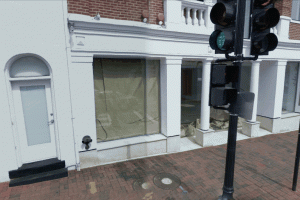 According to the Georgetown Current, Apple has been trying to open a new store in Georgetown since 2007 but has been having problems getting its designs through local review.
According to the Georgetown Current, Apple has been trying to open a new store in Georgetown since 2007 but has been having problems getting its designs through local review.
Apple Inc. claims design geeks as well as computer snobs among its fans, and the company’s storefronts are hallowed ground for those who worship form as much as function.
But Apple’s design credentials seem to hold little sway in Georgetown. Although the company has owned a Georgetown location at 1229 Wisconsin Ave. for more than a year and has approval to demolish the existing structure there, D.C. has yet to get its first Apple store. Moreover, recent delays suggest the wait is far from over.
At its Dec. 2 meeting, the Georgetown advisory neighborhood commission rejected the third consecutive proposal from the California-based store, and the Old Georgetown Board did the same at its meeting two days later.
Planners had hoped the third time would be the charm: “Steve saw this design and really loves it,” said project manager Carrie Johnson, referring to Apple founder Steve Jobs.
Commissioners disagreed with Jobs and claimed the design – a glass first story with a solid-stone upper facade punctuated by a large window shaped like Apple’s logo – would not fit into Georgetown.
Old Georgetown Board members agreed, said board spokesperson Tom Luebke. “The board felt that the design turned the building into a billboard,” he said.
Other board criticisms have been constants since September 2007, when Apple presented its first design, a glass lower story and an upper story that featured punched windows.
“That first time, like every time after, it was a question of scale,” said Luebke. The board wanted something to break up the unrelieved expanse of glass, but Apple returned in the summer of 2008 with an all-glass facade.
“The board wanted something less autonomous, something that supports the historic district,” said Luebke. And again, there was the question of scale.
Although the complaint that the most recent iteration was “too modern” did surface at the neighborhood commission meeting, the moreauthoritative Old Georgetown Board told Apple that a “modern treatment is possible,” according to Luebke.
“They’re not against modern design,” he said of the board.
Another worry has been the one-story approach to the building, formerly the site of a French Connection UK store.
“It didn’t seem that one-story occupancy is an enlightened idea for smart growth in Georgetown,” said Luebke.
Apple Inc. did not return calls for comment.
The brand has had success placing stores in historic and culturally important spots other than Georgetown. A brief survey of existing storefronts, however, shows that Apple’s proposals for the D.C. site more closely echo newer, suburban Apple stores than, for example, the company’s stores on Regent Street in London or in SoHo in New York City.
Those latter stores’ facades, however, were historically protected and therefore retained, while the Wisconsin Avenue site will be demolished.
But Apple will somehow have to adjust its design to its surroundings if it wants to proceed, said Luebke. “So far,” he said, “there has been very little context of the historic district.”
While we wait for the first Washington D.C. store to open, there are many other Apple stores in the D.C. metro area in nearby Virginia (two stores in Arlington, one in Fairfax, and one in McLean, VA) and Maryland (two stores in Bethesda and one in Columbia, MD).